WW2 boat saved from river ahead of restoration
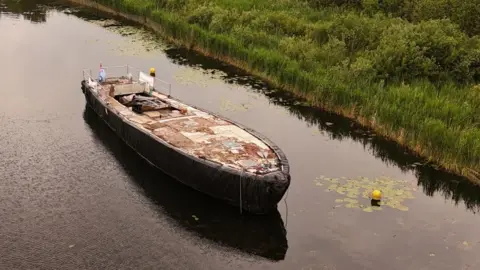 Shaun Whitmore/BBC
Shaun Whitmore/BBCA group of volunteers hope to restore a World War Two rescue boat that has been partly submerged for "close to 20 years".
Whaleback S32s were used by the RAF and Navy to rescue thousands of servicemen who ended up in the sea.
A group called Whaleback for the World believes the 63ft-boat pulled from a river near Horning, Norfolk, and towed to safety is the only known version in the world suitable for restoration.
The volunteers are now trying to raise £20,000 to lift the boat out of the water to a dry place, before deciding if she should be restored as a static vessel on land, which would cost "hundreds of thousands" of pounds, or whether to make her sea-going which they say would cost millions.
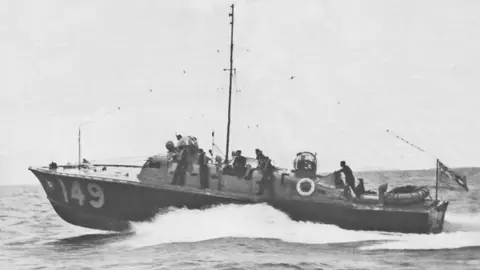 Steve Hale
Steve HaleWhalebacks, so-called due to their graceful whale-like lines embedded in their teak decks, were capable of up to 35 knots, or 40mph.
They played a vital role in the war, rescuing pilots and crews forced to make emergency landings in the sea.
The whaleback in question was purchased for a nominal fee two years ago, having been in private ownership, and is now moored temporarily on Salhouse Broad.
 Shaun Whitmore/BBC
Shaun Whitmore/BBCVolunteer Colin Yorke, who lives in Swaffham, has a personal interest in helping with the restoration, as his father was a whaleback coxswain.
"He served saving lives in very arduous conditions at times," Mr Yorke said.
"Those boats were very rough on the crews, they pounded, punished the lads.
"They were never meant to be lived aboard but the crews did have to live aboard.
"They had very tiny kitchens and they were wet, very wet."
 Shaun Whitmore/BBC
Shaun Whitmore/BBC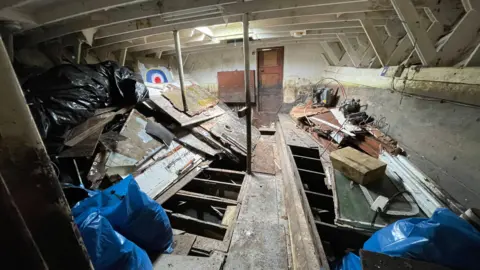 Shaun Whitmore/BBC
Shaun Whitmore/BBCBefore she could be towed, volunteers spent several months plugging her holes and pumping her out.
Nick Schiller, chairman of East Anglian Divers, said carrying out dives to make the repairs had been "quite a challenge", with visibility poor.
Wedges of wood had to be driven into about 20 holes of various sizes to plug them up.
"I think I did five dives in the end, going round the outside, literally finger-tip checking, finding all the holes," Mr Schiller said.
The boat was then wrapped in a plastic lining and towed to her temporary home.
 Shaun Whitmore/BBC
Shaun Whitmore/BBC"It is a bit mad but it was a great project, and now she's up," said Mr Schiller.
He said the next step was to get her out of the water and into a dry dock for further examination and preservation.
"At the moment she's sweating, and that won't do the timbers any good," he said.
The volunteers are now trying to raise £20,000 to lift the boat out of the water to a dry place, before deciding on the next steps.
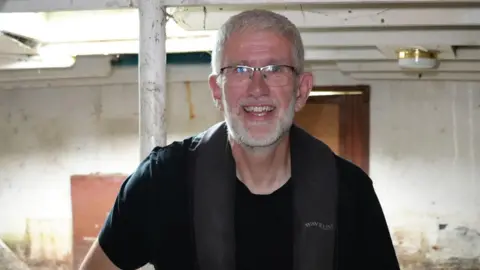 Shaun Whitmore/BBC
Shaun Whitmore/BBCVolunteer Tim Shreeve, who lives in Horning, has helped out for the past six months in getting the boat ready to be moved.
"I'm excited, it's an amazing piece of history, a huge technology for the time, the way she was built," he said.
"Hopefully something that people can look at, and think about the people that actually sailed her and who were rescued by her."
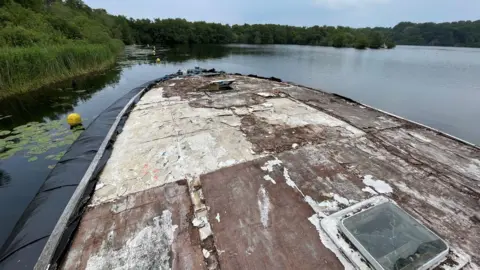 Shaun Whitmore/BBC
Shaun Whitmore/BBCFollow Norfolk news on BBC Sounds, Facebook, Instagram and X.
